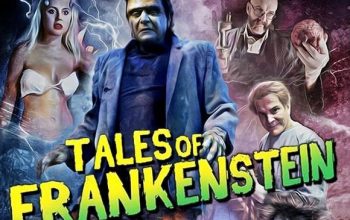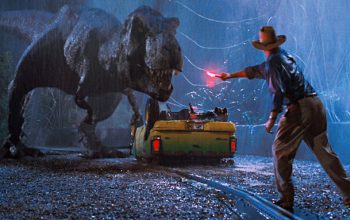Milton the Monster – 1965
I had worked hard for nearly two years, for the sole purpose of infusing life into an inanimate body. For this I had deprived myself of rest and health. I had desired it with an ardour that far exceeded moderation; but now that I had finished, the beauty of the dream vanished, and breathless horror and disgust filled my heart. – Mary Shelley, Frankenstein
I created a monster, when I created that monster! – Professor Weirdo, Milton the Monster
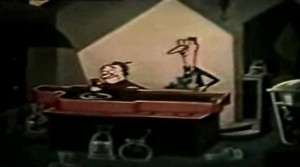
So far, I’ve been looking at Frankenstein stories that are overtly Frankenstein stories. That is to say, ones that have Frankenstein in the title and a character who is named ‘Frankenstein’ in them. Of course, that is only a fraction of Frankenstein media. There’s a whole bunch of stories that are in some way Frankensteinian without using the name directly. Some of the stories I have in mind might be debatable, but I think the Milton the Monster cartoon can categorised as a Frankenstein story without too much controversy.
Milton was the main attraction on a late-sixties TV cartoon show, which also featured superheroic insect Fearless Fly, cowboy Flukey Luke, funny animals Penny Penguin and Muggy-Doo and hobo Snuffy Durma. It consisted of a couple of Milton segments interspersed with those of the other characters.
Milton himself is the creation of diminutive mad scientist Professor Weirdo. Eschewing the post-1931 model of monster making, Weirdo goes back to 19th Century theatrical versions of Frankenstein, in which the Monster was created by alchemy in a vat (on which, more when we get to the 1910 version of Frankenstein). While mixing ‘essence of terror’ and ‘sinister sauce’ Weirdo means to add ‘tincture of tenderness’, a necessary ingredient to prevent his creation from running amok and destroying his creator. Weirdo accidentally pours in too much, and the monster he thus creates is a big lovable goof rather than the force of destruction he has planned.
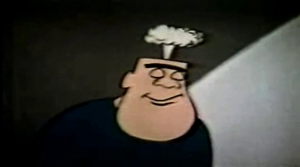
Milton is a big, strong guy with a voice like Gomer Pyle. He has the traditional flat-topped Frankenstein head, which doubles as a chimney. Apparently, he has some sort of fire inside, which puffs out smoke or steam from time to time. Being a fairly passive character, Milton’s adventures are usually the result of someone else’ machinations. Typical stories involved Professor Weirdo’s attempts to either get rid of his disappointing son or make him more monstrous, get-rich-quick schemes (a favorite go-to for cartoon writers of the day) or squabbling for position among the denizens of Horror Hill.
This last one is the interesting part. Horror Hill is your basic, old fashioned haunted house, full of alligators, shrunken heads, Gila monsters and so on. Its occupants include Weirdo and Milton, and Weirdo’s two other monsters/sons, Heebie (a Phantom of the Opera-like character) and Jeebie (a furry cyclops). It is also the home to Count Kook, an effete European aristocrat, whose relationship to Weirdo is vague.
The show’s theme song proclaims that “High on old Horror Hill, in a secret laboratory, Professor Weirdo and Count Kook were in their monstrous glory.” The remainder of the song, it is clear that Weirdo is doing most of the monster making, while Count Kook looks on. Yet it is Kook who jostles Weirdo, causing the spillage of the tincture of tenderness. Put this in a late-sixties TV family context and things get interesting. Kook is in a way is Milton’s co-parent, having performed the maternal duty of contributing ‘tenderness’ to his character. Milton’s mom is a tall man with a mustache and a ridiculous accent.
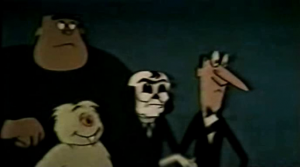
Yes, I am aware that I am overanalysing a silly cheap cartoon from fifty years ago. I’m an English major. It’s what we do. Deal with it.
Obviously, I do not think the creators of the show intended the reading that I have suggested. Weirdo and Kook are clearly shown to sleep in separate rooms, and Kook is nothing but congratulatory when he (wrongly) believes that Weirdo is to be married. Yet, as I hope to show, portrayals of Frankenstein are very easy to see in a queer light simply because they are so often stories of two men acting as co-parents. In the Whale/Karloff Frankenstein, this fact does not quite jump out—the hunchback Karl does not seem a parental figure. But later iterations of the story embrace the idea of the Monster having two male parents. In Frankenstein Created Woman, for example, the monster’s has both a maternal and a paternal mad scientist creator, and both of them are men.
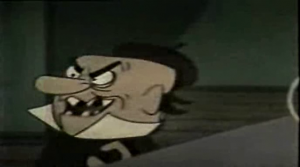
Back to Milton, there’s not much more to say. The animation is cheap and the jokes are mostly largely stale retreads of Charles Addams’ material, though there’s the occasional decent gag. I remember the show making me laugh when I was a kid, so mission accomplished for the creators.

